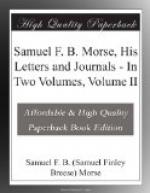“The fact that the lever action of the earliest instrument of 1835 by its click gave the sound of the numerals, as embodied in the original type, is well known, nor is there anything so remarkable in that result.... When you first saw the instrument in 1836 this was so obvious that it scarcely excited more than a passing remark, but, after the adaptation of the dot and space, with the addition of the line or dash, in forming the alphabetic signs (which, as well as I can remember, was about the same date, late in 1835 or early in 1836) then I noticed that the different letters had each their own individual sounds, and could also be distinguished from each other by the sound. The fact did not then appear to me to be of any great importance, seeming to be more curious than useful, yet, in reflecting upon it, it seemed desirable to secure this result by specifying it in my letters patent, lest it might be used as an evasion in indicating my novel alphabet without recording it. Hence the sounds as well as the imprinted signs were specified in my letters patent.
“As to the time when these sounds were practically used, I am unable to give a precise date. I have a distinct recollection of one case, and proximately the date of it. The time of the incident was soon after the line was extended from Philadelphia to Washington, having a way station at Wilmington, Delaware. The Washington office was in the old post-office, in the room above it. I was in the operating room. The instruments were for a moment silent. I was standing at some distance near the fireplace conversing with Mr. Washington, the operator, who was by my side. Presently one of the instruments commenced writing and Mr. Washington listened and smiled. I asked him why he smiled. ‘Oh!’ said he, ’that is Zantzinger of the Philadelphia office, but he is operating from Wilmington.’ ‘How do you know that?’ ’Oh! I know his touch, but I must ask him why he is in Wilmington.’ He then went to the instrument and telegraphed to Zantzinger at Wilmington, and the reply was that he had been sent from Philadelphia to regulate the relay magnet for the Wilmington operator, who was inexperienced in operating....
“I give this instance, not because it was the first, but because it is one which I had specially treasured in my memory and frequently related as illustrative of the practicality of reading by sound as well as by the written record. This must have occurred about the year 1846.”
A serious accident befell the aged inventor, now seventy-nine years old, in July, 1869. He slipped on the stairs of his country house and fell with all his weight on his left leg, which was broken in two places. This mishap confined him to his bed for three months, and many feared that, owing to his advanced age, it would be fatal. But, thanks to his vigorous constitution and his temperate life, he recovered completely. He bore this affliction with Christian fortitude. In a letter to his brother Sidney, of August 14, he says: “The healing process in my leg is very slow. The doctor, who has just left me, condemns me to a fortnight more of close confinement. I have other troubles, for they come not singly, but all is for the best.”




